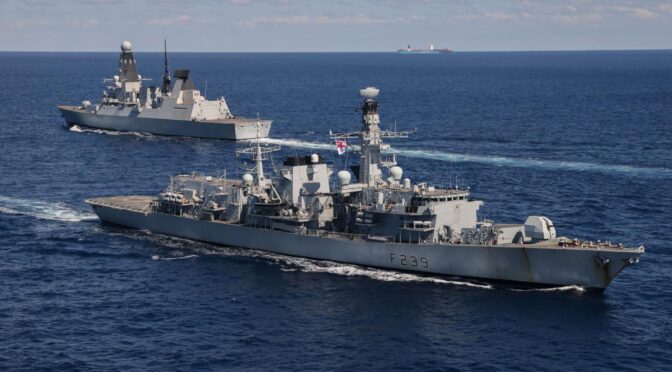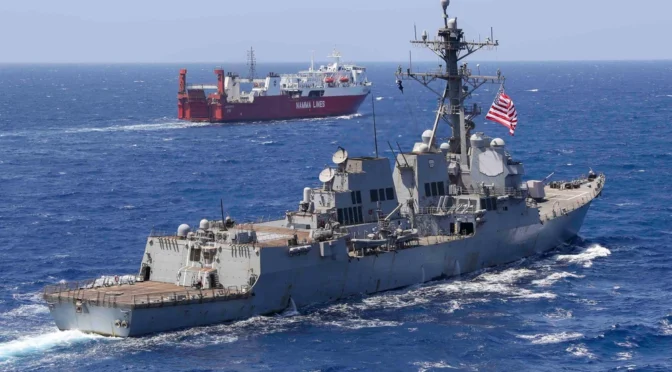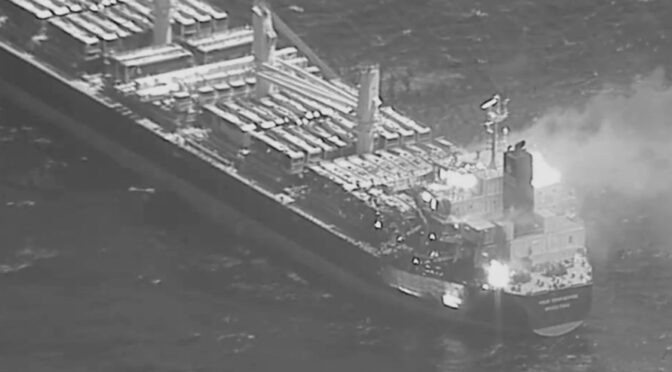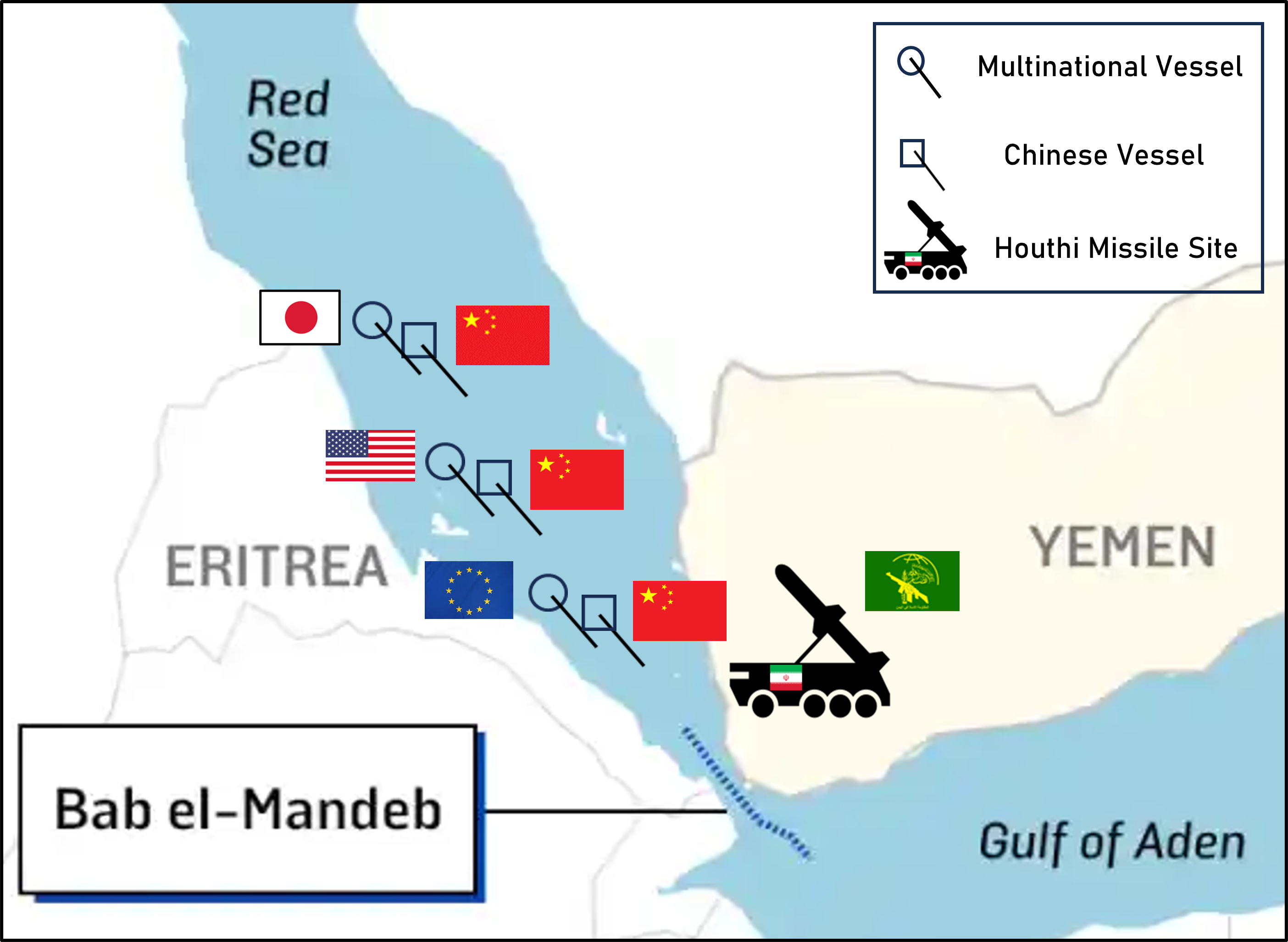By Anna Matilde Bassoli
After more than a year of disrupted global trade, the Red Sea Crisis appears to have no end in sight. Rather, in a series of leaked messages, senior U.S. officials have cast doubts over U.S. involvement and “having to bail Europe out again.” However, while frustration on each side of the pond is understandable, emotions fail to address the root causes of growing transatlantic distrust. The disjointed approach of the U.S. and the European Union to the Red Sea Crisis deserves thorough analysis as a critical yet overlooked cause of transatlantic distress. Indeed, the issue between the transatlantic allies is not who has to bail out whom. Instead, the emergence of the European Union (EU) as a security actor in the maritime domain has weakened the U.S. grip on NATO’s naval strategy. A coherent NATO naval strategy requires the United States and its European allies to align their postures, without the EU as the third wheel.
On December 18, 2023, the United States called upon allies to respond to the Houthi attacks on global shipping with the US-led Operation Prosperity Guardian. This multinational coalition was intended to include the United Kingdom (UK), Canada, France, Italy, the Netherlands, Norway, Spain, and others. However, only the UK, Canada, and Norway upheld their commitment. A few days after this announcement, most European navies withdrew to join the EU-led Operation Aspides, an overlapping defensive mission. Specifically, European navies explicitly rejected US leadership and command in an unprecedented transatlantic schism. The establishment of the EU-led Operation Aspides has resulted in a divided naval commitment and undermined efforts in the Red Sea Crisis in three crucial ways.
First, this divided effort has effectively deprived Prosperity Guardian of European naval assets over the past year. The Italian Navy has committed two destroyers and two frigates to Aspides, contrary to the single frigate initially announced in support of Prosperity Guardian. The French Navy has provided three frigates to Aspides, while it remains unclear what role they would have played in Prosperity Guardian. Similarly, the German and Belgian navies each contributed a frigate. Other European navies have divided their limited commitments between both missions, although it is unclear under which command. For example, the Hellenic Navy provided two frigates to Aspides, while the Royal Netherlands Navy contributed one frigate, a joint support ship, and aviation assets. Even the newest members of NATO, Sweden and Finland, have shown inconsistent commitment, with both countries providing only limited personnel. Despite its initial commitment to the US-led effort, Spain made no contributions. Interestingly, however, Spain’s ports benefited from the crisis, placing the country in an ambiguous position.
These commitments – or lack thereof – contrast sharply with the United Kingdom’s contribution to Prosperity Guardian during the same timeframe. In addition to the destroyers HMS Diamond and HMS Duncan, the Royal Navy provided two frigates and critical air support. While this still pales compared to the US show of force, it demonstrates the UK’s consistency in its transatlantic commitment. The other European powers cannot claim to have done similarly. The Danish Navy, for instance, sent the HDMS Iver Huitfeldt, but ship malfunctions plagued its performance, resulting in the dismissal of the Danish chief of defense. Furthermore, the French Navy has prioritized French-linked vessels, indicating that national interests rather than transatlantic ones drive their participation.
Second, the European decision to withdraw from participation in Prosperity Guardian shows how Europe was already veering towards strategic autonomy before the Trump administration came to the White House. Upon announcement, the Italian Ministers of Foreign Affairs and Defense specified that Italy, France, and Germany were pushing for an EU-only operation of a purely defensive nature, without land strikes. This European insistence on going solo deserves a deep dive. For starters, Europeans have criticized the Trump administration’s stance on transatlantic relations in recent weeks, calling for renewed unity. However, the lack of European support for the US-led effort demonstrates that European conduct has been inconsistent with their leaders’ rhetoric and parallel maritime commitments. For instance, Europeans have been eager to participate in Indo-Pacific exercises and showcase these efforts as a sign of strong friendship. In the same breath, Spain has actively participated in NATO exercises in the Mediterranean. However, a key question arises: how can the United States truly trust its European allies if they only show up to train and not to engage?
In this respect, the US offensive approach against the European defensive posture demonstrates that the transatlantic allies could not be more distant. By the time European navies were rotating their naval forces in the summer of 2024, some commentators had already started casting doubts on the effectiveness of Prosperity Guardian as a purely defensive mission. In response to this lack of results, the United States doubled down on eliminating the Houthi threat and deterring further attacks with strikes on Houthi positions in Yemen under Operation Poseidon Archer. Once again, however, European commitment has been limited, and preference has been given to the defensive posture of Operation Aspides. The problem plagues transatlantic relations is not the Trump administration’s aggressive stance towards Europe. Rather, the lack of entente between the US’s forward-leaning posture and the EU’s defense posture has eroded trust and partnership across the Atlantic.
Third, the US’s lack of acknowledgment of the EU as a security actor has undermined its efforts. Most recently, Michael C. DiCianna has argued that “Europe needs to fight the Houthis.” However, his analysis focuses only on Prosperity Guardian, as if it were the only ongoing operation in the Red Sea, incorrectly accounting for the European contribution. Similarly, Doug Livermore acknowledges European contributions but employs a US-only perspective to make the case for using force in the Red Sea Crisis. Neither of these authors seems to grasp the actual problem. It is not that Europe does not fight – from the European perspective, they are protecting sea lines of communication (SLOCs). Rather, the European and US perspectives on transatlantic security and interests do not align.
This analytical bias highlights two major problems in the US debate. First, it shows that the United States only views Europe through NATO lenses, while Europeans increasingly look to the EU to bolster their security needs. Operation Prosperity Guardian and Operation Aspides began while transatlantic relations were still good. So, why did the Europeans part ways with the United States? The most evident answer points to European strategic autonomy, meaning a European defensive approach for European interests within the EU.
As evident in the Red Sea, none of this concerns the United States. Rather, Aspides attempts to demonstrate that Europe could rely on the EU as a security actor. The strong push behind an EU-led, European-only defense, particularly regarding defense spending and the primary US request since the first Trump administration, is not the result of a sudden storm. Instead, renewed US aggressiveness has further nudged the Europeans towards strategic autonomy. Indeed, Europeans have been most vocal and proactive regarding their security, not within NATO, but in the EU. The EU will never fight for US interests or in the US way. This is not what the EU was created for. On the contrary, this was why NATO was established, making it an organization suited to defend US and European interests in the American way.
This also highlights the second major problem in the US debate. Because the United States ignores the EU as a security actor, it fails to recognize that the EU and NATO rely on two opposite perspectives. Misunderstanding the difference between the EU’s inward-focused posture and the US’s forward-leaning one undermines US attempts to reset transatlantic relations. While US commentators correctly ask Europeans to contribute more, they overlook their counterparts’ perspective. From the US point of view, fighting the Houthis means not only preventing attacks on the seas but also bombing their positions on land. For Europeans, this is excessive, rendering US complaints about their conduct dangerously pointless.
In no other domain has this mistaken approach had more consequences than in the naval domain. The US viewpoint is forward-leaning – hence, offensive – towards protecting SLOCs, involving heavy military force. On the other hand, the European perspective is reactive, building convoy-like defenses around commercial ships. In short, Americans prefer to charge ahead, whereas Europeans tend to build trenches. The Red Sea Crisis exemplifies this dynamic.
The Euro-American split has resulted in two overlapping operations acting from different perspectives without a common end goal. While the EU-led Operation Aspides focuses solely on protecting commerce, US-led efforts have multilayered strategic goals: protecting SLOCs, demonstrating maritime strength on the global seas, and eroding Iran’s influence in the Middle East by striking its proxies. From the US viewpoint, these goals are not isolated but interconnected ends on a dynamic maritime chessboard, where the ultimate objective is to checkmate China. From the European perspective, China is not even on the board.
Indeed, contrary to popular US belief, the Red Sea Crisis is not about European trade; rather, it is about US sea power. The United States is not fighting the Houthis to bail out freeloading Europeans. This view is contrary to US interests and damaging to US strategy. The United States is taking charge of a maritime crisis because it can still be the premier global maritime power. This demonstration of maritime strength sends two messages. First, the United States still dominates the seas. Second, the United States is not a dead sea power to China. Underestimating the value of these messages in the context of strategic competition with China is a fatal mistake for the US.
To be fair, concerns about straining US naval forces are valid and must be addressed. However, once again, these concerns must be addressed in accordance with US naval strategy, not against it. Indeed, an increased European commitment should not continue on the premise of split naval strength. This is an open subversion of all the basic principles of US naval strategy: overwhelming naval power, control of the sea lines of communications, and maritime dominance. If the United States concedes any of these to either friend or foe, the sea power that has supported US freedom and prosperity will crumble.
The United States must leverage NATO to align transatlantic allies. This will require two key steps. First, the United States must tone down its anger towards its transatlantic allies. Autonomy-seeking Europeans might be more incentivized to maintain their defensive posture if they view the United States as an adversary. So far, this trend has been evident, and there is no reason for the United States to make Europeans even less inclined to contribute to transatlantic efforts.
The second step could involve a more structured division of labor in the Red Sea. Throughout history, very few maritime crises involving land-based attacks on commercial shipping have ended without a major deployment of strength. While the United States has a strong interest in striking the Houthis to keep Iran in check, the Europeans have an interest in keeping SLOCs open. The current approach – the United States striking the Houthis from the sea while the Europeans continue their convoy-like missions – is a good starting point. However, the split command and lack of matching European resources must cease. To make this work, the Europeans should reduce their commitments in the Indo-Pacific until the Red Sea Crisis is resolved. This would allow the United States to allocate resources effectively between the two connected theaters. Likewise, the United States should clarify that a unified command is crucial to bring this crisis to a halt.
A better understanding of expectations and goals in the Red Sea could generate premises to mend transatlantic fences. Presently, no one has the perfect recipe to bring this crisis to a halt, and a split approach has likely extended the crisis. Not only have the Houthis taken the lead in messaging victory, but the first true victim of this crisis – the Israeli port of Eilat – has fallen under financial pressure. Time has run out for the United States to complain about Europe without a plan. Likewise, time has proven that the European Union is still not a reliable security actor. An integrated NATO strategy that accounts for both US and European perspectives is the only choice for victory. The alternative option spells defeat.
Anna Matilde Bassoli holds a M.A. in Security Studies from Georgetown University’s Security Studies Program and a MLitt in Strategic Studies from the University of St Andrews. She also earned a B.A. in Political Science and International Relations from Catholic University of the Sacred Heart in Milan, Italy. She currently works in the think tank industry, focusing on tech policy and security.
Featured Image: The UK Royal Navy (RN) Type 23 frigate HMS Richmond (foreground) and Type 45 destroyer HMS Diamond hand over on station as the RN vessel contributing to Operation Prosperity Guardian. (Photo by UK Ministry of Defence)






